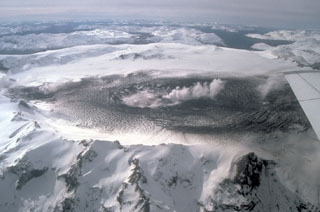Report on Cerro Hudson (Chile) — February 1993
Bulletin of the Global Volcanism Network, vol. 18, no. 2 (February 1993)
Managing Editor: Edward Venzke.
Cerro Hudson (Chile) Increased gas emission and mudflows
Please cite this report as:
Global Volcanism Program, 1993. Report on Cerro Hudson (Chile) (Venzke, E., ed.). Bulletin of the Global Volcanism Network, 18:2. Smithsonian Institution. https://doi.org/10.5479/si.GVP.BGVN199302-358057
Cerro Hudson
Chile
45.9°S, 72.97°W; summit elev. 1905 m
All times are local (unless otherwise noted)
The following, from Peter Ippach and Rolf Kilian, describes observations during a caldera crossing and overflight between 11 February and 5 March. These are the first reported caldera observations since January 1992 (16:12). One of the largest eruptions of the 20th century began on 8 August 1991 from a fissure cutting the caldera rim (16:7-12, and 17:3). The paroxysmal phase began on 12 August, producing eruption columns up to 16-18 km for 3 days, resulting in ashfall in the Falkland Islands, 1,000 km away. Pyroclastic flows were mostly restricted to the caldera floor, and a lava flow traveled 4 km down the WNW flank.
The basaltic eruption phase of 8-9 August 1991 (16:8) took place on the W caldera rim under 20-30 m of ice, forming an elliptical N 25°W-trending fissure vent about 2.5 km long, 300 m wide, and 200 m deep. A lava flow from the eruption extended 3.5 km WNW along the Huemules glacier from the N flank of the fissure vent (see map in 16:7); it had a maximum thickness of 8 m. Lava debris flows and aa-like flows were observed on the N flank extending up to 2.5 km from the source. Lava- and spatter-flows traveled down the slope of the inner W caldera rim, one traveling 800-1,000 m before going into a 300 m-deep depression on the ice-covered caldera surface. The proximal fallout layer is about 1-5 m thick with individual pumice clasts up to 40 cm in diameter. Constant fumarolic activity was observed, and there was an intense sulfur smell.
Since the andesitic Plinian eruption of 12-15 August 1991 (16:7), gas emission has apparently increased in a 10 km2 area surrounding the vents. Gas columns from different locations were rising to 500 m altitude. A young phreatic eruption had produced a fan of reworked pyroclastic material 10 km to the E. Mudflow production has intensified as a result of strong geothermal activity increasing glacial melting. Volcaniclastic material was flowing in erosional channels SE of the caldera and following the Huemules glacier WNW. The increased mud- and mass-flow production in the Huemules valley is similar to the April 1973 volcaniclastic flow that followed the 1971 eruption. This implies a continuing risk for the valley, which is inhabited during the summer.
Crater-like depressions in a 5 km2 area in the SW part of the caldera probably indicated two eruption centers from the August 1991 eruption. The depressions contained lakes 650 m and 800 m in diameter, surrounded by an intensively cracked glacier. Pyroclastic material was reworked and redeposited in the lower NW part of the caldera during the austral summer of 1991/92, leaving deposits up to 50 m thick. These deposits were then covered by snow during the winter of 1992. Geothermal activity was not present in the NE part of the caldera.
Pyroclastic material on the SE-directed fan from the August 1991 eruption, between the Ibáñez and Murta rivers, was also extensively reworked during the 1991/92 summer. After a rainy summer, reworking and deposition had stopped by March 1993, with a great reduction in ash transport by the rivers. However, on the W side of the volcano, irregular meltwater flows from the Huemules glacier carried a large amount of pyroclastic material down the Huemules river.
Geological Summary. The ice-filled, 10-km-wide caldera of Cerro Hudson volcano was not recognized until its first 20th-century eruption in 1971. It is the southernmost volcano in the Chilean Andes, related to subduction of the Nazca plate beneath the South American plate. The massive volcano covers an area of 300 km2. The compound caldera is drained through a breach on its NW rim, which has been the source of mudflows down the Río de Los Huemeles. Two cinder cones occur N of the volcano and others occupy the SW and SE flanks. This volcano has been the source of several major Holocene explosive eruptions. An eruption about 6,700 years ago was one of the largest known in the southern Andes during the Holocene; another eruption about 3,600 years ago also produced more than 10 km3 of tephra. An eruption in 1991 formed a new 800-m-wide crater in the SW portion of the caldera.
Information Contacts: P. Ippach, GEOMAR; R. Kilian, Universität Tübingen, Germany.

